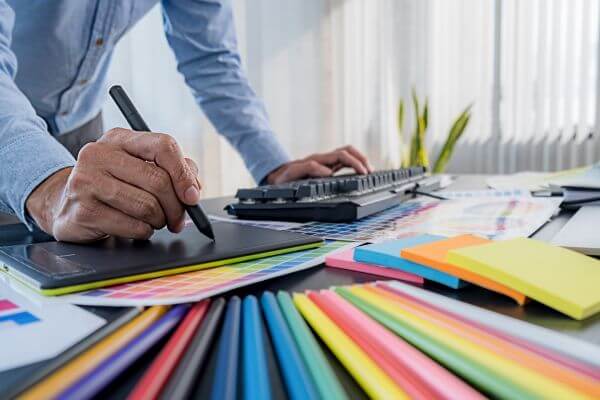Remote Work Strategies: How to Be an Effective Freelance Designer from Home
Working from home as a freelance designer gives you freedom and the chance to be your own boss. Yet, it can bring new hurdles that might lower your productivity. This article will guide you with essential strategies and advice to make your freelance designing journey successful. We will cover tips on creating an efficient workspace and managing your time wisely.
Key Takeaways:
- Create a dedicated work space in your home to optimize focus and productivity.
- Establish a consistent daily routine to maintain a healthy work-life balance.
- Set clear goals and deadlines to stay motivated and organized.
- Adopt effective communication tools and practices for smoother collaboration.
- Maintain a healthy work-life balance through self-care and prioritizing well-being.
Set Up a Dedicated Work Space in Your Home.
Creating a work space at home is key for freelance designers. It boosts productivity and focus. A separate work area helps switch into a professional mode. It also keeps your work and personal life balanced.
To make your freelance design space great, follow some tips:
- Choose a quiet and well-lit area: Find a place in your home free from distractions to work better. Having enough natural light can also make you feel better and work more efficiently. If that’s not possible, add good lighting near your desk.
- Invest in ergonomic furniture: It’s important to have a comfortable desk and chair. They should be adjustable to support your body well, and maintain a good posture while working.
- Organize your tools and supplies: A clean and organized workspace helps you work more efficiently. Use shelves, drawers, and organizers for your tools, files, and stationary items.
- Create a visually inspiring environment: Add art, plants, or décor that you love. This will not only make your workspace look nice but also encourage creativity and new ideas.
- Ensure a reliable internet connection: For online tasks and meeting clients, a strong and fast internet connection is a must. Choose a good internet service to keep your work smooth.
Creating a work-only space in your home is more than just setting up a desk. It sets boundaries, helping you manage time, stay focused, and establish good working habits. As a freelance designer, these things are crucial to succeed.
Establish a Daily Routine and Stick to It.
Being a freelance designer means a daily routine is key. It keeps a good balance and boosts productivity. By setting work hours, you use your time well and steer clear of things that distract you.
Here are some strategies to help you establish a daily routine that works for you:
- Set specific work hours: Find out when you do your best work. It might be early or late. Make these hours your special work time to really get things done.
- Create a schedule: Make a plan for your daily tasks. Break them into parts and set times for each. This way, you can keep organized and focus on what’s important.
- Avoid multitasking: Doing more than one thing at a time can slow you down. Focus on one task till it’s done. This way, you’ll work more efficiently.
- Take regular breaks: Make sure to have short breaks. They help prevent burnout and keep you feeling good. Use this time to move around, relax, or do something fun.
- Minimize distractions: Find what distracts you and get rid of it. This might mean turning off social media or using apps that help you stay focused. This keeps you on track during work hours.
Tip: Try different routines to see what’s best for you. Don’t forget, what works for someone else might not be right for you. Find the routine that helps you work well without burning out.
Example of a Productive Daily Routine
| Time | Activity |
|---|---|
| 8:00 AM – 9:00 AM | Morning routine (exercise, breakfast, etc.) |
| 9:00 AM – 10:00 AM | Check and respond to emails |
| 10:00 AM – 11:30 AM | Focus on high-priority design project |
| 11:30 AM – 12:00 PM | Short break (stretch, hydrate, etc.) |
| 12:00 PM – 1:00 PM | Lunch break |
| 1:00 PM – 3:00 PM | Collaborate with clients/team members |
| 3:00 PM – 4:30 PM | Work on additional design tasks and revisions |
| 4:30 PM – 5:00 PM | Wrap up the day, plan for next day |
Sticking to a daily routine helps you keep a good balance and use your time wisely. Try different approaches to find what suits you best. With the right routine, you can thrive as a freelance designer.
Set Clear Goals and Deadlines.
As a freelance designer, clear goals and deadlines are key. They help you stay organized and on track. They give you a sense of purpose and keep you motivated. By setting design goals, you work towards your long-term vision step by step.
Make sure your goals are SMART—specific, measurable, attainable, relevant, and time-bound. This makes them clear and actionable. For instance, a good goal isn’t just “improve design skills.” A SMART goal would be “complete a UI/UX design course in three months to boost your design skills.”
It’s also crucial to set project deadlines. These deadlines make sure you use your time well and finish projects on time. Break big projects into smaller steps with their own deadlines. This approach keeps you from putting things off and helps you make steady progress.
Use good time management strategies to meet these deadlines. Prioritize your tasks and make a schedule. Tools like calendars and task managers can be a big help. Figure out when you work best and try to schedule your work then. This way, you can get more done in less time.
“The key to successful time management is to identify your personal peak productivity hours, set clear goals, and break down projects into smaller tasks with specific deadlines.”
Keep checking on your progress and tweaking your goals and schedules as necessary. Regular evaluations against your goals help you stay on the right path. Make changes as needed to keep moving forward towards your freelancing goals.
| Goal-Setting Technique | Description |
|---|---|
| SMART Goals | A framework for setting specific, measurable, attainable, relevant, and time-bound goals. |
| Prioritization | Identifying and focusing on high-priority tasks to achieve efficient time management. |
| Breaking Down Projects | Dividing large projects into smaller, manageable tasks with specific deadlines. |
| Regular Review | Consistently evaluating progress towards goals and adjusting plans if necessary. |
Adopt Effective Communication Tools and Practices.
For freelance designers, good communication is key. It keeps you connected with clients and team members. This means talking clearly and often throughout any design work. Use the best tools and tips to make your job go smoothly.
Collaboration Platforms:
Using platforms for teamwork is very helpful for freelancers. They act as a main space for sharing files and getting feedback in real-time. Trello, Asana, and Basecamp are top choices for managing projects and talking to others easily. They keep everyone updated and on track.
Remote Communication Tools:
Freelancers have many tools for talking to others from afar. Video calls with Zoom and Google Meet let you see each other as you work. This is great for personal and productive talks. For quick chats, Slack and Microsoft Teams make messaging fast and simple. They help you get answers, go over ideas, and share news with anyone involved.
Best Practices for Effective Communication:
Having good tools is not enough. You need to use them well. Here are some hints for better talking:
- Start conversations and reply to messages quickly to seem professional.
- Speak clearly and simply to avoid any confusion.
- Meet regularly with clients and others to keep them informed and clear up any issues.
- Write down important talks and choices to have a project history and avoid mistakes.
- Keep your tone friendly and helpful to build strong working relationships.
Using the right communication tools and methods can make you a better freelancer. It helps work go smoothly, improves teamwork, and makes clients happier with your service.
Maintain a Healthy Work-Life Balance.
Freelance designers often struggle to balance work and life. Working from home brings freedom but also means taking care to avoid overworking. It’s key to put self-care first and set limits to keep a healthy work-life balance.
Self-Care Practices
For freelance designers, taking care of yourself is crucial. Make time for activities that reduce stress and bring joy. This could be doing exercise, meditating, or enjoying hobbies. Keeping physically and mentally fit helps with work and creativity.
Setting Boundaries
It’s essential to draw lines between work and personal time. Create clear working hours and let clients know when you’re available. Don’t be afraid to refuse extra work that might overwhelm you. This helps you stay focused and relaxed when you’re not working.
“The key to maintaining a healthy work-life balance is to learn the power of discernment and prioritize both your work and personal well-being.”
Avoiding Burnout
Burnout can lower your job satisfaction and creativity. Be on the lookout for burnout signs and take steps to prevent it. Make sure your workload is manageable and take regular breaks. Your health is as important as meeting deadlines.
Work-Life Balance Benefits
Finding a good work-life balance benefits you in many ways. It makes you happier and more satisfied with your work. This happiness boosts creativity and work quality. Balancing work and life lets you enjoy time with loved ones and hobbies. It improves your overall health and helps you succeed in your freelance career in the long term.
| Benefits of a Healthy Work-Life Balance |
|---|
| Improved overall well-being |
| Enhanced creativity and productivity |
| Reduced stress and burnout |
| Better physical and mental health |
| Stronger personal relationships |
| Ability to pursue other interests and hobbies |
Sharpen Your Skills and Stay Relevant in the Industry.
Staying sharp in the fast-changing world of design is key for freelancers. As tech evolves and trends shift, keeping up is a must. Here are ways to keep your edge as a freelance designer.
1. Stay Updated with Industry Trends
Stay current by reading top design blogs and joining online communities. Also, sign up for newsletters. This helps you predict what clients will want. You can then offer designs that meet these current needs.
2. Continue Learning
Always aim to grow and learn more. Online courses, webinars, and workshops can step up your game. Sites like LinkedIn Learning and Skillshare are filled with expert courses. Growing your skills make you more valuable and opens up new project doors.
3. Network and Collaborate
Networking with others in design is crucial. Go to events, join meetups, and use sites like Behance. Also, partnering with fellow designers brings fresh ideas and chances for bigger projects. Solid teamwork can tackle tough design projects and make them stand out.
4. Showcase Your Work
Updating your portfolio often is vital. It shows off your range and creativity, proving you’re adaptable. A well-made digital portfolio or using sites like Behance helps attract those looking for design help.
5. Seek Feedback and Implement It
Feedback is your friend in getting better. Welcome feedback from all sources to improve your skills and work. Using criticism as a chance to improve, your designs will get even better. This leads to happy clients and more work.
Through continuous learning and staying up-to-date on trends, freelance designers stand out. Committing to learning and being flexible in the industry keeps your business strong.
Financial Management and Freelance Design.
For freelance designers, managing money well is crucial for success. Use smart budgeting to control your finances. This means watching what you spend and dividing money for personal and work needs. Such discipline helps you make smart money moves and use resources wisely.
Sending clear, professional invoices is vital. It makes getting paid easier and helps you get your money on time. Keep a system to watch invoice payments and remind clients to pay if they’re late. This keeps your cash flow smooth.
Knowing your tax duties is a must, too. Learn the tax laws in your area and keep good records of your money. Getting advice from a tax expert can help you save money and follow the rules. Doing your taxes right reduces worry and boosts how much you take home.
These tips – about budgeting, sending invoices, and handling taxes – set the stage for a successful freelance design career. Focus on both keeping your money in check and being creative. Balancing both aspects can lead to a long and rewarding career in freelance design.





